C Z U Profile Roll Forming Equipment for Efficient Metal Fabrication Solutions
The Evolution and Efficiency of C Z U Roll Forming Machines
In the realm of modern manufacturing, roll forming machines have emerged as essential tools for producing a variety of metal components. Among these, C Z U roll forming machines are particularly noteworthy for their versatility and efficiency. These machines are specifically designed to produce channel-shaped components in the form of C, Z, and U profiles, widely used in construction, automotive, and various other industries.
Understanding Roll Forming
Roll forming is a continuous bending operation in which a long strip of metal, usually steel or aluminum, is shaped into a desired profile by passing it through a series of rollers. Each roller alters the shape of the material incrementally until the final product emerges. The process is efficient, allowing for high-volume production with minimal waste, making it economically advantageous for manufacturers.
The Design of C Z U Roll Forming Machines
C Z U roll forming machines are ingeniously designed to accommodate the unique shapes they create. These machines incorporate advanced technology that allows for rapid adjustments between different profiles. For instance, switching from producing C-shaped channels to Z or U-shaped components can be achieved with minimal downtime due to modular tooling systems. This adaptability is crucial for manufacturers who need to respond to varying demands without lengthy setup times.
Typically, these machines consist of several key components - Material Feed Section The raw metal sheets are fed into the machine, where they are aligned and prepared for shaping. - Roller Stations A series of rollers progressively shape the material into the desired profile. Each station has a specific role in the bending process, ensuring accurate and consistent dimensions. - Cutting System Once the desired length of the profiles is achieved, a cutting system slices the continuous strip into individual components. - Control Panel Modern C Z U roll forming machines come equipped with sophisticated control systems that monitor the entire process, allowing for real-time adjustments and quality control.
c z u roll forming machine

Applications of C Z U Profiles
The primary advantage of C Z U profiles lies in their structural integrity and load-bearing capabilities. C profiles are often used in construction for wall framing and support beams. Z profiles are ideal for purlins, facilitating roof structures in commercial buildings, while U profiles are extensively utilized in railings and brackets. The versatility of these shapes allows them to be employed in a wide range of applications, enhancing the efficiency and durability of the structures they contribute to.
Advantages of Using C Z U Roll Forming Machines
1. Cost-Effective Production These machines enable high-speed production, minimizing labor costs and reducing material waste, which is crucial for maintaining profitability. 2. Precision Engineering The automated systems ensure high accuracy and repeatability, leading to lower tolerances in the final products. 3. Customization Options Manufacturers can easily customize profiles according to specific engineering requirements by adjusting the roll design and spacing. 4. Scalability The modular nature of C Z U roll forming machines allows manufacturers to scale production up or down with ease, catering to market demands.
Conclusion
C Z U roll forming machines represent a significant advancement in the manufacturing landscape. Their ability to produce complex shapes efficiently and economically makes them indispensable in various industries. As technology continues to evolve, these machines are expected to incorporate even more innovative features, further enhancing their functionality and efficiency. In a world where precision and cost-effectiveness are paramount, the C Z U roll forming machine stands out as a key player in the drive towards modern manufacturing excellence.
-
Roof Panel Machines: Buying Guide, Types, and PricingNewsJul.04, 2025
-
Purlin Machines: Types, Features, and Pricing GuideNewsJul.04, 2025
-
Metal Embossing Machines: Types, Applications, and Buying GuideNewsJul.04, 2025
-
Gutter Machines: Features, Types, and Cost BreakdownNewsJul.04, 2025
-
Cut to Length Line: Overview, Equipment, and Buying GuideNewsJul.04, 2025
-
Auto Stacker: Features, Applications, and Cost BreakdownNewsJul.04, 2025
-
Top Drywall Profile Machine Models for SaleNewsJun.05, 2025








